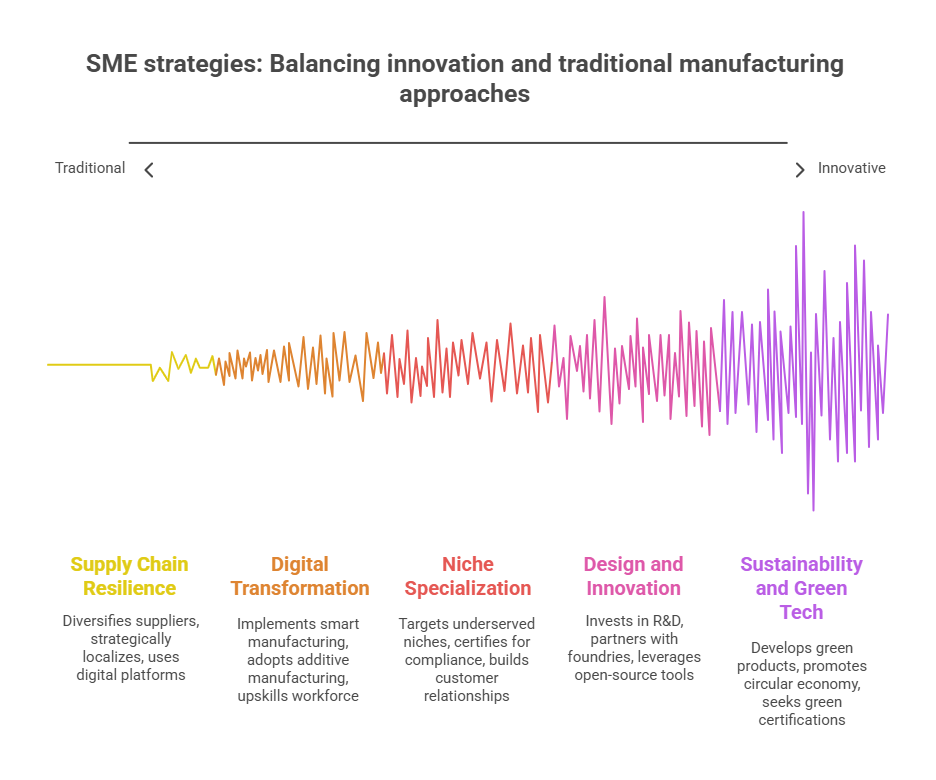Embracing the Future: Why Small and Mid-Sized Electronics Companies Must Rethink Manufacturing
Discover how small and mid-sized electronics companies can thrive amidst the manufacturing delusion by embracing innovation, specialization, and sustainability. Explore actionable strategies to redefine your role in the industry.
JoeZ
6/14/20257 min read


Introduction: The Manufacturing Delusion and Its Impact on Electronics SMEs
In a recent article, The Economist argues that governments worldwide are gripped by a "manufacturing delusion," pouring trillions into industrial policies that prioritize factories over other economic drivers, often with questionable returns. The piece highlights how this obsession with manufacturing—driven by myths about job creation, economic growth, and national security—may lead to inefficient resource allocation and missed opportunities in other sectors. For small and mid-sized electronics companies (SMEs), this global trend presents both challenges and opportunities. Unlike large conglomerates, SMEs in the electronics sector operate with tighter budgets, leaner workforces, and less political clout, making it critical to navigate this landscape strategically.
This blog post takes a unique perspective: rather than viewing the manufacturing push as a threat or a misguided policy, we see it as a catalyst for SMEs to innovate, pivot, and redefine their role in the electronics ecosystem. By focusing on agility, specialization, and emerging technologies, small and mid-sized electronics firms can not only survive but thrive in an era where traditional manufacturing is overrated. Below, we explore why the manufacturing delusion matters, how it affects electronics SMEs, and actionable strategies to stay competitive in a rapidly evolving industry.
The Manufacturing Delusion: A Closer Look
The Economist outlines several myths fueling the global manufacturing craze. First, there’s the belief that manufacturing inherently drives economic growth. While factories can create jobs, the article notes that modern manufacturing is increasingly automated, reducing its labor impact. Second, governments assume manufacturing strengthens national security by reducing reliance on foreign supply chains, yet global interdependence often persists. Third, the promise of "green jobs" through industrial policies like the U.S. CHIPS Act or Europe’s state-aid tweaks may not deliver the expected economic boost, as subsidies often distort markets and favor large players.
For electronics SMEs, these myths translate into real-world pressures. Large corporations like Intel or TSMC can leverage government incentives, securing massive subsidies to build or expand semiconductor fabs. Meanwhile, smaller firms face rising costs for components, regulatory hurdles, and competition from heavily subsidized giants. The article cites examples like Singapore, South Korea, and Taiwan, where manufacturing-focused policies have boosted GDP but rely on scale and specialization that SMEs struggle to replicate.
Yet, this environment isn’t a death knell for SMEs. Instead, it’s a wake-up call to rethink traditional manufacturing and embrace strategies that play to their strengths: flexibility, niche expertise, and proximity to customers.
The Unique Position of Electronics SMEs
Small and mid-sized electronics companies occupy a critical niche in the global supply chain. They produce specialized components, provide contract manufacturing, or develop innovative products like IoT devices, medical electronics, or automotive sensors. Unlike tech giants, SMEs can pivot quickly, adapt to market shifts, and serve specialized markets that don’t require mass production. However, the manufacturing delusion creates a skewed playing field, where government policies favor large-scale factories over agile innovators.
Consider the semiconductor industry, a cornerstone of electronics. The U.S. CHIPS Act has funneled billions into building new fabs, but most benefits flow to giants like TSMC or Samsung. SMEs, which often focus on design, assembly, or niche components, may see little direct support. Similarly, tariffs and export controls—aimed at reshoring manufacturing—can increase costs for SMEs reliant on global supply chains. The Economist warns that such policies may backfire, creating inefficiencies that harm smaller players most.
Despite these challenges, SMEs have a unique opportunity to redefine their role. By focusing on innovation, sustainability, and digital transformation, they can turn the manufacturing delusion into a springboard for growth.
Strategy 1: Embrace Design and Innovation Over Production
One of the biggest myths debunked by The Economist is that manufacturing is the only path to economic success. For electronics SMEs, this means prioritizing design and intellectual property (IP) over capital-intensive production. Semiconductor design, for instance, requires less physical infrastructure than fabrication but can yield high margins. Companies like Arm Holdings thrive by licensing chip designs rather than manufacturing them, a model SMEs can emulate in niche markets.
Actionable Steps:
Invest in R&D: Allocate resources to develop proprietary technologies, such as specialized sensors or low-power IoT chips. For example, a small firm could focus on designing chips for wearable health devices, a growing market with less competition from giants.
Partner with Foundries: Instead of building factories, collaborate with established foundries like GlobalFoundries or smaller regional players. This reduces capital expenditure while leveraging cutting-edge manufacturing capabilities.
Leverage Open-Source Tools: Use open-source design software or platforms like RISC-V to lower costs and accelerate innovation. This approach allows SMEs to compete without massive R&D budgets.
By focusing on design, SMEs can create high-value IP that commands premium prices, sidestepping the capital-intensive trap of traditional manufacturing.
Strategy 2: Specialize in Niche Markets
The Economist notes that manufacturing’s scalability benefits large players, but SMEs can excel by targeting underserved niches. In electronics, this could mean focusing on markets like medical devices, aerospace components, or renewable energy systems, where customization and reliability trump mass production.
Case Study: Medical Electronics
A small electronics firm in Germany recently carved out a niche producing high-precision sensors for ventilators. By focusing on quality and regulatory compliance, it secured contracts with global healthcare giants, despite lacking the scale of larger competitors. This specialization shielded it from tariff wars and subsidy-driven competition.
Actionable Steps:
Identify Emerging Trends: Research markets like green energy, autonomous vehicles, or smart agriculture, where specialized electronics are in demand. For instance, sensors for precision farming are a $7 billion market projected to grow 10% annually.
Certify for Compliance: Invest in certifications like ISO 13485 for medical devices or AS9100 for aerospace, which signal quality and open doors to high-margin contracts.
Build Customer Relationships: Focus on long-term partnerships with clients in niche sectors, offering tailored solutions that larger firms can’t match.
Specialization allows SMEs to command premium prices and avoid direct competition with subsidized giants.
Strategy 3: Adopt Digital Transformation and Automation
Automation is a double-edged sword in the manufacturing delusion. While it reduces job creation (a key government goal), it’s a boon for SMEs looking to optimize operations. The Economist highlights that modern factories rely heavily on automation, which SMEs can leverage to stay competitive without massive scale.
Actionable Steps:
Implement Smart Manufacturing: Use IoT and AI to monitor production lines, predict maintenance needs, and reduce downtime. For example, a mid-sized PCB manufacturer could use predictive analytics to cut defects by 20%.
Adopt Additive Manufacturing: 3D printing for prototyping or small-batch production can lower costs and speed up development cycles, especially for custom components.
Upskill Your Workforce: Train employees in digital tools like CAD/CAM software or data analytics to enhance productivity. Community colleges and online platforms offer affordable training programs.
By embracing automation, SMEs can achieve efficiency gains that rival larger competitors, even with smaller production volumes.
Strategy 4: Rethink Supply Chains for Resilience
The manufacturing delusion often emphasizes reshoring to reduce reliance on foreign suppliers, but The Economist argues this oversimplifies global interdependence. For electronics SMEs, supply chain disruptions—whether from tariffs, geopolitical tensions, or natural disasters—pose significant risks. Building resilient supply chains is critical.
Actionable Steps:
Diversify Suppliers: Source components from multiple regions to mitigate risks. For example, a U.S.-based SME could work with suppliers in Mexico and Vietnam alongside traditional Asian partners.
Localize Strategically: While full reshoring may be impractical, consider nearshoring to reduce lead times and costs. Mexico, for instance, has become a hub for electronics assembly due to its proximity to the U.S.
Use Digital Platforms: Platforms like ThomasNet or Alibaba can help identify reliable suppliers and streamline procurement, reducing dependency on single sources.
A resilient supply chain ensures SMEs can weather disruptions while maintaining cost competitiveness.
Strategy 5: Capitalize on Sustainability and Green Tech
The Economist critiques the overhyped promise of “green jobs” in manufacturing, but sustainability remains a powerful differentiator for SMEs. Consumers and regulators increasingly demand eco-friendly products, and electronics SMEs can lead in areas like energy-efficient devices or recyclable components.
Actionable Steps:
Develop Green Products: Design low-power electronics or devices with recyclable materials. For example, a mid-sized firm could create energy-efficient power supplies for data centers, a market projected to grow to $20 billion by 2030.
Promote Circular Economy Practices: Offer repair or recycling programs for your products to appeal to environmentally conscious customers.
Seek Green Certifications: Certifications like Energy Star or RoHS compliance can enhance marketability and open doors to government contracts.
By aligning with sustainability trends, SMEs can attract customers and investors while differentiating from mass-market competitors.


Navigating Government Policies: Opportunities and Pitfalls
While The Economist warns that industrial policies often favor large firms, SMEs can still tap into government programs. For instance, the U.S. CHIPS Act includes grants for smaller companies involved in the semiconductor supply chain, such as those producing testing equipment or packaging solutions.
Actionable Steps:
Research Funding Opportunities: Explore grants or tax incentives for R&D, workforce training, or energy efficiency. The U.S. Small Business Administration (SBA) offers resources to navigate federal programs.
Advocate Through Associations: Join industry groups like the Electronics Components Industry Association (ECIA) to influence policy and access networking opportunities.
Stay Compliant: Ensure compliance with trade regulations and export controls to avoid penalties, especially in geopolitically sensitive areas like semiconductor exports.
By strategically engaging with government programs, SMEs can access resources without being overshadowed by larger players.
Conclusion: A New Path Forward for Electronics SMEs
The manufacturing delusion, as The Economist describes, is a global phenomenon driven by flawed assumptions about factories as the backbone of economic growth. For small and mid-sized electronics companies, this presents a complex landscape of challenges—rising costs, subsidized competitors, and supply chain risks—but also immense opportunities. By focusing on innovation, specialization, digital transformation, supply chain resilience, and sustainability, SMEs can carve out a competitive edge in a world obsessed with manufacturing.
The future belongs to agile, forward-thinking firms that prioritize value creation over physical production. Whether it’s designing cutting-edge chips, serving niche markets, or embracing green technologies, electronics SMEs have the tools to thrive. The key is to act decisively, leveraging your unique strengths to navigate a world where traditional manufacturing is no longer the only path to success.
Call to Action
Assess Your Strategy: Conduct a SWOT analysis to identify how your firm can pivot away from traditional manufacturing dependencies.
Invest in Skills: Train your team in emerging technologies like AI, IoT, or additive manufacturing to stay ahead of the curve.
Engage with Peers: Join industry forums or trade associations to share insights and advocate for SME-friendly policies.
By redefining your role in the electronics ecosystem, your company can not only survive the manufacturing delusion but emerge as a leader in the next era of innovation.
